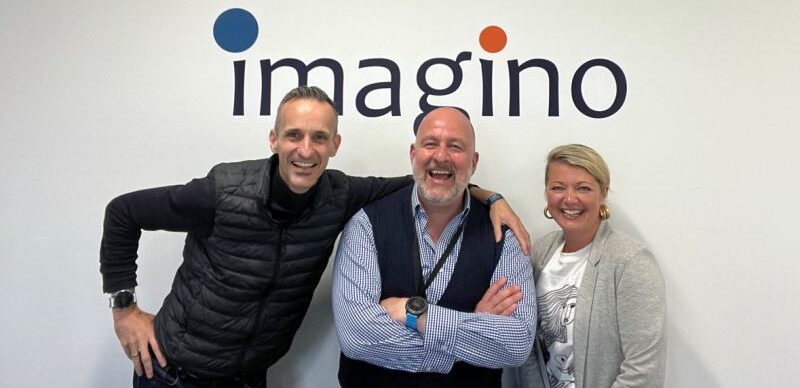In this series, we’re chatting with Marketing teams and IT teams across all industries. We’re answering their questions in the most straightforward and bullshit-free way possible. You don’t need AI, you need to Ask imagino…
‘How do I get started with vendor selection for data solutions, spot a black-hearted villain, and WHY are you all so obsessed with three-letter-acronyms?’
Why are there so many TLA’s in the world of MarTech? I’m so confused: CDP, CRM, CXP, ETL, DMP – and that’s before we start including things that basically sound the same – data lake, database, data cloud, data warehouse…
There are two main reasons why we’ve seen this explosion:
- The first relates to the fact that there is no real consensus on how to solve the problem of data unification, enhancement and activation. Essentially every MarTech vendor approaches this from the angle of their own solution and coins their own terms. If a vendor’s solution is a hammer, every problem must be a nail. THE solution hasn’t been found, even though we’ve been at this for 15 years. So every new approach, unfortunately, means a new set of terms or a new TLA. This is partly down to the purchaser as well. You may have already invested in a “CDP” that hasn’t been successful. if you’re going to the Board for another MarTech investment you probably don’t want to say it’s for another CDP.
- The overall data solution market is massive. Because it’s so busy it’s another way, sometimes one of the few ways, companies can differentiate.
In this crowded complex marketplace – with all these confusing terms and acronyms – how do I start to define what I need to fix my data problems?
It’s tough. If you need to send emails, you’d look for an ‘email service provider’. It does what it says on the tin. But the data solution landscape isn’t as straightforward.
The scope of many of these data solutions is undefined, the challenge is that you can’t go to the market and say “I need a CDP”. It can mean a multitude of different things, and the functionality between different CDPs can vary enormously. I recommend starting from the other side. Start with your problem and what you need to solve. Don’t start by looking for a solution within category X.
- What do need to achieve?
- What part of the experience do you want to improve?
- Do you want to increase the level of personalisation in emails, online, on the website, in your ads, in your stores?
Once you’ve defined that scope you might find there are several products that will solve that problem.
A common mistake I see, which has been propagated by Big Red and Big Blue, is the belief that there’s a single product or supplier that can fix everything. It’s always more complicated than that. If your use cases are specific, defined and need quick action – huge rip and replace options won’t be the most effective path. This is why I recommend the composable approach. Areas of your tech stack will probably be working fine – there’s no immediate need to start replacing everything. You need to plug gaps, increase effectiveness and output and importantly maximise those MarTech investments that you’ve already made (and had to go 10 rounds with the Board to secure funding for).
Really look at whether your data ecosystem needs a massive overhaul or simply a helping hand. We frequently talk to marketers who are happy that their data lake is fine, the daily data flows are fine – they’re struggling with real time and trigger-based journeys for example. That’s the specific issues they want to solve.
So I should approach vendors based on their history of solving similar use cases to mine?
Yes exactly. Doing that, and not just ploughing through a list of vendors with the right three letter acronyms will be far more effective. You’re also helping yourself to avoid scope creep by keeping a clear focus (for both you and the vendors) on the key use cases you want to solve first.
Once I’ve found some vendors that look like a good fit, how do I narrow it down? In my experience everyone says they can do everything! But that’s not always been the case.
From all the conversations I’ve had with marketers and tech teams, the quickest way to differentiate your selected vendors is to ask for a Proof of Concept project. Even asking for a POC, and gauging their willingness and confidence to engage with that will give you a strong indicator. Are they happy to do a workshop with you, and complete a clear scope? If they are keen and able to do a POC over the next few weeks and demonstrate how your use case could be achieved, as opposed to saying that they need a 3-year contract and a 6-month project to get you up and running, that answers your question.
Would I not get the same information by simply asking for a demo?
I don’t want to denigrate my fellow vendors – but it’s incredibly easy to put together a pre-canned glossy demo. Demos are useful from a User Experience perspective – you can see how you’d practically use the tool. Even then I’d recommend changing a parameter on the day of the demo – perhaps swap seeing a ‘lifetime value segment’ for a ‘last product browsed plus non-engaged for the last 6 weeks segment’ and assess how responsive the vendor is and how quickly they can adapt the tool to show you that. But ideally, doing it for real through a POC is going to give you the most accurate assessment of whether or not this is going to work.
Finding a partner that is willing to invest their time and energy up front to demonstrate to you that they can solve your problems is a far better indicator of future success. If they’re not that interested or engaged before you’ve signed on the dotted line, it’s unlikely they’ll care any more once they’ve got your hard-fought for budget.
What’s Next?
Stay tuned for the next part of our AI series. For more resources explore our latest eBook, We’re Here to Slay the CDP Monster and whitepaper Why Marketing Clouds are Failing CRM Teams.
Ask imagino questions were answered by Mathieu Lavedrine, VP of Customer and Technology











